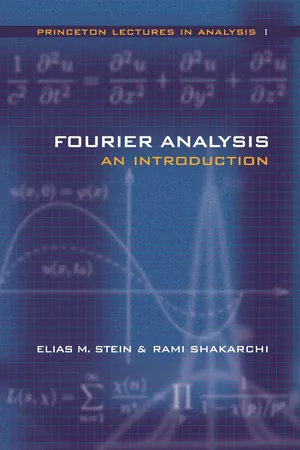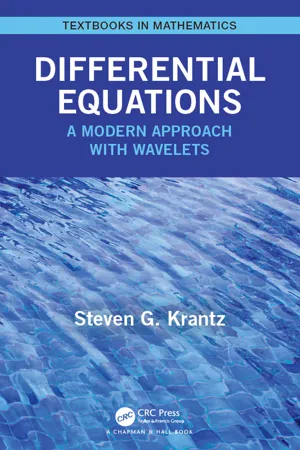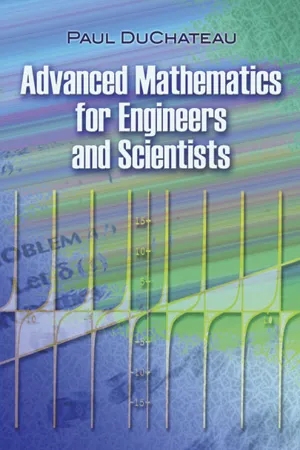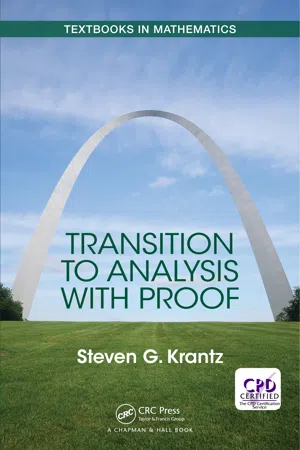Technology & Engineering
Convergence of Fourier Series
The convergence of Fourier series refers to the ability of a Fourier series to approximate a given function. It is said to converge if the Fourier series approaches the function as the number of terms in the series increases. The convergence of Fourier series is important in signal processing and other areas of engineering.
Written by Perlego with AI-assistance
Related key terms
Related key terms
1 of 4
Related key terms
1 of 3
8 Key excerpts on "Convergence of Fourier Series"
- eBook - ePub
Fourier Analysis
An Introduction
- Elias M. Stein, Rami Shakarchi(Authors)
- 2011(Publication Date)
- Princeton University Press(Publisher)
3 Convergence of Fourier SeriesThe sine and cosine series, by which one can represent an arbitrary function in a given interval, enjoy among other remarkable properties that of being convergent. This property did not escape the great geometer (Fourier) who began, through the introduction of the representation of functions just mentioned, a new career for the applications of analysis; it was stated in the Memoir which contains his first research on heat. But no one so far, to my knowledge, gave a general proof of it . . .G. Dirichlet, 1829In this chapter, we continue our study of the problem of Convergence of Fourier Series. We approach the problem from two different points of view.The first is “global” and concerns the overall behavior of a function f over the entire interval [0, 2π]. The result we have in mind is “mean-square convergence”: if f is integrable on the circle, thenAt the heart of this result is the fundamental notion of “orthogonality”; this idea is expressed in terms of vector spaces with inner products, and their related infinite dimensional variants, the Hilbert spaces. A connected result is the Parseval identity which equates the mean-square “norm” of the function with a corresponding norm of its Fourier coefficients. Orthogonality is a fundamental mathematical notion which has many applications in analysis.The second viewpoint is “local” and concerns the behavior of f near a given point. The main question we consider is the problem of pointwise convergence: does the Fourier series of f converge to the value f (θ ) for a given θ ? We first show that this convergence does indeed hold whenever f is differentiable at θ . As a corollary, we obtain the Riemann localization principle, which states that the question of whether or notSN(f )(θ ) → f (θ ) is completely determined by the behavior of f in an arbitrarily small interval about θ . This is a remarkable result since the Fourier coefficients, hence the Fourier series, of f depend on the values of f - eBook - ePub
- David. Bleecker(Author)
- 2018(Publication Date)
- Chapman and Hall/CRC(Publisher)
4 /90.4.2 Convergence Theorems for Fourier Series
Recall that in order to solve initial/boundary-value problems for the heat equation, one must approximate initial temperature functions by linear combinations of sine and/or cosine functions of an appropriate form. If the Fourier series of a function converges to the function, then we may achieve the desired approximation by considering a sufficient number of terms of the Fourier series. We stated a convergence result (Theorem 2 of Section 4.1 ) that is valid for C1 functions f(x) (–L ≤ x ≤ L) such that f(–L) = f(1) and f′(–L) = f′(L). In this section, we prove this result, as well as other convergence theorems that apply to a more general class of functions. Roughly speaking, this broader class consists of functions which are C1 on [−L,L], except for a finite number of points where their graphs have jumps or corners (i.e., piecewise C1 ). Although almost everyone who plans to use Fourier series should clearly understand the statements of these convergence theorems, their proofs (as well as proofs of preliminary results) are not necessarily of great utility in applications. Nevertheless, there are enough details supplied in these proofs so that they can be understood by the interested reader.Periodic functions
Before proving the convergence theorems, we will need to establish some preliminary results. We begin with some facts concerning periodic functions and periodic extensions of functions.Definition. A function g(x), defined for all real x, is said to be periodic (of period 2L), if g(x+2L) = g(x) for all x.This means that if the graph of g(x) is moved to the right or left by a distance of 2L (or any multiple of 2L), then the graph falls exactly on the top of itself. The functions sin(nmc/L) and cos(njx/L) are examples of periodic functions of period 2L. Indeed, sin(nx(x+2L)/L) = sin(nmc/L + 2π) = - eBook - ePub
- Wen Li, Weiming Sun(Authors)
- 2022(Publication Date)
- CRC Press(Publisher)
3 The Generalized Fourier Series with Accelerated ConvergenceDOI: 10.1201/9781003194859-3Fourier series will lose much of its luster in expanding a nonperiodic function, even when this function is defined sufficiently smooth on a compact interval. It is well known that a continuous function can always be expanded into a Fourier series inside the interval; the word “inside” is highlighted to emphasize the fact that the two end points shall be excluded, unless proven otherwise. While this may not seem to be a big deal at the first glance, it actually has profound implications to the validity and efficacy of the Fourier series when used to approximate a function or solve a boundary value problem. In what follows, a strategy will be discussed on how to improve the convergence of the Fourier series expansions of a locally-defined sufficiently smooth function.3.1 IMPROVING THE Convergence of Fourier Series
The Convergence of Fourier Series is perhaps the most important concern in practical applications. Faster convergence implies that a relatively small number of terms in the series expansion may lead to a decent approximation to the original function regardless of whether the function is explicitly known or not. Perhaps more importantly, the convergence rate dictates if the term-by-term differentiations can be directly applied to the Fourier series of a function or solution to obtain the series representations for its derivatives, as often encountered in solving differential equations or boundary value problems.By recognizing the slower convergence of sine series than its cosine counterpart, a modified Fourier series was proposed as (Iserles and Nørsett, 2008 )f ( x ) =(3.1)+a 0/ 2],∑m = 1∞[a mcos m x +b msin ( m −1 2) xIff ( x )is differentiable and its derivative has bounded variation, the expansion coefficients,a mandb m, in (3.1) will both decay likeO ((Adcock 2011m)− 2 - eBook - ePub
Differential Equations
A Modern Approach with Wavelets
- Steven Krantz(Author)
- 2020(Publication Date)
- Chapman and Hall/CRC(Publisher)
6 Fourier Series: Basic Concepts • The idea of Fourier series • Calculating a Fourier series • Convergence of Fourier Series • Odd and even functions • Fourier series on arbitrary intervals • Orthogonality 6.1 Fourier Coefflcients Trigonometric and Fourier series constitute one of the oldest parts of analysis. They arose, for instance, in classical studies of the heat and wave equations. Today they play a central role in the study of sound, heat conduction, electromagnetic waves, mechanical vibrations, signal processing, and image analysis and compression. Whereas power series (see Chapter 3) can only be used to represent very special functions (most functions, even smooth ones, do not have convergent power series), Fourier series can be used to represent very broad classes of functions. For us, a trigonometric series or Fourier series is one of the form f (x) = 1 2 a 0 + ∑ n = 1 ∞ (a n cos n x + b n sin n x). (6.1.1) We shall be concerned with three main questions: 1. Given a function f, how do we calculate the coefficients a n, b n ? 2. Once the series for f has been calculated, can we determine that it converges, and that it converges to f ? 3. How can we use Fourier series to solve a differential equation? We begin our study with some classical calculations that were first performed by Euler. (1707–1783). It is convenient to assume that our function f is defined on the interval [− π, π ] = { x ∈ R : − π ≤ x ≤ π }. We shall temporarily make the important assumption that the trigonometric series (6.1.1) for f converges uniformly. While this turns out to be true for a large class of functions (continuously differentiable functions, for example), for now this is merely a convenience so that our calculations are justified. We apply the integral to both sides of (6.1.1). The result. is ∫ − π π f (x) d x = ∫ − π π (1 2 a 0 + ∑ n = 1 ∞ (a n cos n x + b n sin n x)) d x = ∫ − π π 1 2 a 0 d x + ∑ n = 1 ∞ ∫ − π π a n cos n x d x + ∑ n = 1 ∞ ∫ − π π b n[--=PL - Mangey Ram, J. Paulo Davim, Mangey Ram, J. Paulo Davim(Authors)
- 2018(Publication Date)
- CRC Press(Publisher)
chapter twoFourier series and itsapplications in engineering
Smita Sonker and Alka Munjal National Institute of Technology Kurukshetra Contents 2.1 Introduction 2.2 Periodic functions 2.3 Orthogonality of sine and cosine functions 2.4 Fourier series 2.5 Dirichlet’s theorem 2.6 Riemann–Lebesgue lemma 2.7 Term-wise differentiation 2.8 Convergence of Fourier Series 2.9 Small order 2.10 Big “oh” for functions 2.11 Fourier analysis and Fourier transform 2.12 Fourier transform 2.13 Gibbs phenomenon 2.13.1 Gibbs phenomenon with an example 2.13.2 Results related to Gibbs phenomenon 2.14 Trigonometric Fourier approximation 2.15 Summability 2.15.1 Ordinary summability 2.15.2 Absolute summability 2.15.3 Strong summability 2.16 Methods for summability 2.17 Regularity condition 2.18 Norm 2.19 Modulus of continuity 2.20 Lipschitz condition 2.21 Various Lipschitz classes 2.22 Degree of approximation 2.23 Fourier series and music 2.24 Applications and significant uses References2.1 Introduction
Mathematics has its roots embedded within various streams of engineering and sciences. The concepts of the famous Fourier series were originated from the field of physics. The following two physical problems are the reasons for the origin of Fourier series:- Heat conduction in solid
- The motion of a vibrating string
Jean Baptiste Joseph Fourier (1768–1830) was the first physicist, mathematician, and engineer who developed the concepts of Fourier analysis in dealing with the problems of vibrations and heat transfer. He claimed that any continuous or discontinuous function of t could also be expressed as a linear combination of cos(t ) and sin(t ) functions.In the mathematical analysis, we do not usually get a full decomposition into the simpler things, but an approximation of a complex system is usually achieved by a more elementary system. When we truncate the Taylor series expansion of a function, we approximate the function by using the polynomial.- eBook - ePub
- (Author)
- 1949(Publication Date)
- Academic Press(Publisher)
x = 0 can be deduced from the behavior of the two mirror image parabolas which meet there. Curve 3 consists of two cubic parabolas, that osculate with continuous curvature. The scale, which for convenience has been chosen differently for the different curves, can be seen by the ordinates of the maximal values which have been inserted on the right hand side.The increasing continuity of our curves 0 to 3 has its counterpart in the increasing rate of convergence of the Fourier series on the right sides of eqs. (5) to (8) : in (5) we have a decrease of the coefficients like 1/k , in general, in accord with our theorem, we have a decrease withk, where n is the order of the first discontinuous derivative of the represented function.−n −1The Convergence of Fourier Series stands in a marked contrast to that of Taylor series. The former depends only on the continuity of the function to be represented and its derivatives on the real axis, the latter depends also on the position of the singularities in the complex domain. (Indeed the singular point nearest the origin of expansion in the complex plane determines the radius of convergence of the Taylor series.) Accordingly the principles of the two expansions are basically different: for Fourier series we have an oscillating approach over the entire range of the interval of representation, for Taylor series we have an osculating approach at its origin. We shall return to this in §6 .§4 Passage to the Fourier Integral
The interval of representation− π < x < πcan be changed in many ways. Not only can it be displaced, as remarked on p. 14, but also its length can be changed, e.g., to−a < z < + afor arbitrary a . This is done by the substitution(1)which transforms (1.7) into(2)In the more convenient complex way of writing (1.12) , one then has(3)We may obviously consider also the more general interval b < z < c , by substituting(4)The formulas (2) then become(5)In this connection we mention some “pure sine and cosine series” that appear in Fourier’s work. One considers a function f (x ) which is given only in the interval0< x < π - Paul DuChateau(Author)
- 2013(Publication Date)
- Dover Publications(Publisher)
Note that the functions have the same definitions on the interval [0, π] but each of the three differs from the other two on [−π, 0]. In particular, we haveConvergence of Fourier Series
PROBLEM 7.8 Discuss the convergence of the Fourier series generated in Problem 7.3 SOLUTION 7.8The periodic extension ƒ 2π of the function from Problem 7.3 is shown in Figure 7.3 and is clearly continuous for all x . The derivative of this function can be obtained by inspection from the graph of the piecewise linear function ƒ 2π (x ) or it can be calculated from the definition of ƒ (x):Then ƒ ′(x) is discontinuous at π/2 and −π/2 but the one sided limits of ƒ ′(x ) at these points clearly exist. Then ƒ ′2π 2π is piecewise continuous. In addition, the second derivative ƒ ″(x ) exists and equals zero at each point where ƒ ′(x ) is continuous, and at points of discontinuity for ƒ ’(x ), the one sided limits for ƒ ″ exists (and equal zero from both sides).Figure 7.3 Periodic Extension Showing Symmetry about π/2Then it follows from Theorem 7.2 that the Fourier series for ƒ (x ) converges uniformly to ƒ 2π (x ). In addition, Theorem 7.5 implies that this series can be differentiated term by term and the series obtained converges pointwise to the average of the left and right hand limits of the derivative ƒ ′2π (x ). That is, the differentiated seriesconverges pointwise to the square wave function ƒ ′2π (x ). In particular, at the points −π/2 and π/2 where ƒ ′(x ) is discontinuous, the differentiated series is convergent to the value zero since (ƒ ′(−π/2−) + ƒ ′(−π/2+))/2 = (+1 − 1)/2 = 0 and (ƒ ′(π/2−) + ƒ ′(π/2+))/2 = (−1 + 1)/2 = 0.PROBLEM 7.9 Discuss the convergence of the Fourier series generated in Problem 7.4. SOLUTION 7.9The function ƒ (x ) = x 2 on [−π, π] has a continuous 2π-periodic extension. The derivative of this function is ƒ ′(x ) = 2x , −π ≤ x ≤ π, and this function has a 2π-periodic extension that is piecewise continuous but not continuous. That is, the derivative has finite jump discontinuities at integer multiple of π, but the one sided limits of the derivative exist. This derivative is just two times the function pictured in Figure 7.1 (b). The second derivative ƒ ″(x ) exists and equals zero at each point where ƒ ′(x ) is continuous and thus ƒ ″2π- eBook - ePub
- Steven Krantz(Author)
- 2017(Publication Date)
- Chapman and Hall/CRC(Publisher)
Chapter 12 Sequences and Series of Functions 12.1 Convergence of a Sequence of Functions Preliminary Remarks Sequences and series of functions play a pivotal role in modern mathematics, and also in engineering and physics. The theory of Fourier series, just as an example, was invented in the early nineteenth century as a means of decomposing a fairly arbitrary function into simple units (namely sines and cosines). The more modern theory of wavelets takes the Fourier theory to new heights of beauty and power. A sequence of functions is usually written f 1, f 2,... or { f j } j = 1 ∞. We will generally assume that the functions f j all have the same domain S. Definition 12.1 A sequence of functions { f j } j = 1 ∞ with domain S ⊂ R is said to converge pointwise to a limit function f on S if, for each x ∊ S, the sequence of numbers { f j (x)} converges to f (x). E XAMPLE 12.2. Define f j (x) = x j with domain S = { x : 0 ≤ x ≤ 1 }. If 0 ≤ x < 1 then f j (x) → 0. However, f j (1) → 1. Therefore the sequence f j converges pointwise to the function f (x) = 0 i f 0 ≤ x < 1 1 i f x = 1. See Figure 12.1. We see that, even though the f j are each continuous, the limit function f is not. Figure 12.1 The sequence { x j }. Here are some of the basic questions that we must ask about a sequence of functions f j that converges to a function f on a domain S : If the functions f j are continuous, then is f continuous? If the functions f j are integrable on an interval I, then is f integrable on I ? If f is integrable on I, then does the sequence ∫ I f j (x) d x converge to ∫ I f (x) d x ? If the functions f j are differentiable, then. is f differentiable? If f is differentiable, then does the sequence f j ′ converge to f ’ ? We see from Example 12.2 that the answer to the first question is “no”. Each of the f j is continuous but f certainly is not. It turns out that, in order to obtain a favorable answer to our questions, we must consider a stricter notion of convergence of functions
Index pages curate the most relevant extracts from our library of academic textbooks. They’ve been created using an in-house natural language model (NLM), each adding context and meaning to key research topics.
Explore more topic indexes
Explore more topic indexes
1 of 6
Explore more topic indexes
1 of 4







